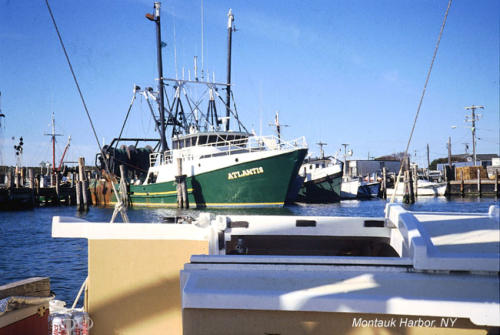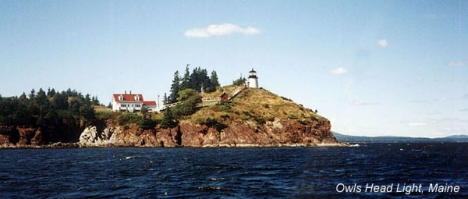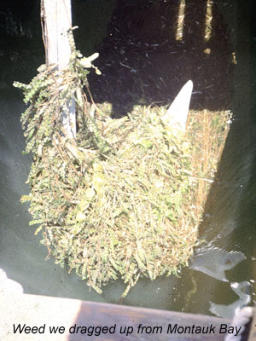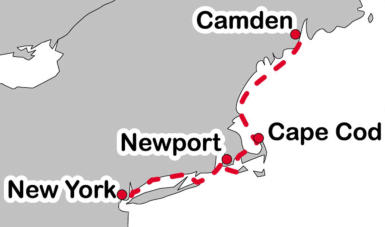Chapter 3
Oborea in New England
September 1991
We arrived in Camden Maine on the leading edge of a cold front on August 31st, 1991 but next day the wind, still blowing
out of a clear sky, moderated a bit and we decided to sail straight on to Cape Cod, following the offshore buoys round the
coast rather than sailing straight across the Gulf of Maine. The air was crystal clear as we left Penobscot Bay and we
bounded along at seven knots in the offshore wind. During
the night though things slowed down a bit and by the
middle of the next morning we were becalmed near the
Isle of Shoals north of Cape Ann. It was Labour Day and
everyone was out fishing—we were surrounded by small
boats. We were not getting anywhere though, and we
decided to motor on to Gloucester on the south side of the
cape. But before we got there a south west wind sprang up
raising a steep chop from dead ahead. The guide book
recommended an alternate route for such conditions, up
the Annisquam River and through a short canal directly to
Gloucester Harbor, cutting off the cape. On a holiday
weekend this provided a little more excitement than we
expected or needed.
Imagine the West Gap into Toronto harbour on a crowded summer holiday weekend, then draw it out to a length of a
couple of miles with strong tides, shoals at each side, blind corners, yachts on moorings and two draw bridges thirty eight
feet wide. We crept through the last of these bridges at about two knots under full throttle against the tide with a line up of
boats behind us, another line up of boats waiting to go the other way and two line ups of cars waiting to cross the bridge!
In the heyday of the fishing schooner races Gloucester was the chief rival of Lunenburg and it is interesting to compare the
two harbours. In Lunenburg there is room for a hundred yachts to anchor and there are usually less than a dozen.
Gloucester has space for a hundred and there are two hundred crowded in. It is also exposed to swells coming in from the
sea. We managed to squeeze into a small space in Lighthouse Cove where we spent an uncomfortable night rolling around
and bumping the bottom at low tide. We decided to leave first thing in the morning.
Tuesday 3rd September was sunny and clear with strong south west winds which meant we would be close hauled for the
forty mile run to Provincetown on the tip of Cape Cod, but with a reef in both main and mizzen we slipped away in fine
style riding comfortably over the swells; a departure only slightly marred by getting a lobster trap float wrapped in our
rudder (these thing are all over New England). Off to starboard the towers of Boston were visible above the horizon and
around us were a few fishing boats. All morning the wind grew gradually lighter. We shook out the reefs and put up bigger
sails until by three we were almost becalmed with the Pilgrim Tower at Provincetown poking above the horizon ahead.
Suddenly the wind came back strongly, building up a short sea in no time at all and we had to scramble to get the reefs
back in. At the same time fin whales started breaching around us, we could see four or five within a two mile radius,
leaping high into the air to fall back with an immense splash or rolling onto their sides and waving their long fins and tails
in the air. Two whale watching boats were near us and Oborea was doing quite a bit of splashing on her own, pounding
into head seas that threw up sheets of spray and sent things flying off the galley shelves. In the sparkling sunlight and deep
blue seas it was an afternoon to remember.
The pound to windward lasted for three hours, all the way to Provincetown Harbour, with one tack to the west to avoid the
race off Race Point. Once behind the long curling sandspit though we were in sheltered waters and found a comfortable
anchorage behind the town wharf.
The atmosphere of Provincetown is unique, with a very active arts community, a thriving tourist trade and a busy
commercial fishing industry (most of the fishermen are of Portuguese decent). Many famous American writers and artists
have lived or at least spent time here on the Cape and art galleries, bookstores, Portuguese bakeries and tacky T shirt
shops line the narrow main street. We spent four days, two of them rainy, waiting for the right winds to cross Cape Cod
Bay to the canal.
The Cape Cod Canal is only about seven miles long, but it cuts off a very long run around the outside of the Cape and
around the dangerous Nantucket Shoals. Because it connects Cape Cod Bay which has ten foot tides with Buzzards Bay
and four foot tides there are strong currents through it.
When we did finally leave it was in fog in company with two other yachts, but by half way across the sun came out and we
had unlimited visibility and we did the twenty mile crossing in three hours. We went through the canal with three knots of
current under us for a total of eight knots over the ground and anchored off the Point Independence Yacht Club in Onset
Bay. The canal marked a transition for us from the cooler rocky foggy seas of the Maritimes and New England to the
warmer waters and sandy shores of Buzzards Bay and points south; the boat started to dry out. We would miss the rugged
unspoiled scenery and friendly people of Nova Scotia, but not the fog or the damp.
At the yacht club we learned of the damage wrought by hurricane Bob which had passed directly over the area. The whole
beach had been littered with yachts, we saw pictures of some that had been swept several hundred yards inland by the
tidal surge and helicopters had been used to get them back to the water. At the club one boat had even landed on the fuel
dock and smashed the pumps. In the club house we were shown the high tide mark on the wall about ten inches above the
floor. Broken tree limbs were still everywhere and we realised how lucky we had been in Lunenburg.
Buzzards Bay is long and narrow and open to the prevailing south west winds which build up a notorious chop, but we left
Onset with very light winds and in fact only made eighteen miles that day, anchoring in pretty Hadley Harbour off Woods
Hole, the principal entrance to Nantucket Sound.
Next day was again crystal clear and sunny with light
south east winds (we didn't miss the fog a bit) and we
made it to Newport, Rhode Island and actually saw a
number of multihulls on the way; up to now they had
been as scarce as clear days.
Newport, the yachting mecca, is large and crowded.
Start or finish of many ocean races and long
associated with the Americas Cup it breathes
yachting and attracts boats from all over the world.
We anchored in a fleet of hundreds next to a double-
ender from Argentina and a couple of boats over
from the Tilly Endurable. There were also some big
French catamarans and several millionaires'
megayachts but dominating them all was 150 foot
mast of Shamrock, Sir Thomas Lipton's Americas
Cup challenger of 1928; restored by the Lipton Co.
and presented to the Yachting Museum here. Ashore
we had breakfast at the Seamens' Institute (which
also has excellent showers) and stocked up on charts
at the Armchair Sailor, a big nautical bookstore.
Our next body of water, Block Island Sound also has a reputation for uncomfortable seas.
We left Narragansett Bay in company with a fleet of racing monohulls and a coast guard
cutter with winds on the port quarter, but dipping into five foot swells from the south. An
hour and a half later as we rounded Point Judith the winds picked up and the seas grew
steeper. Oborea found herself plunging her bows right under at eight knots. There was a
mad, wet scramble to reduce sail and then the wind went light again! The confused seas
continued all across the sound until we neared the east tip of Long Island where we bounced
through one brief tide race and into the narrow dredged channel to the perfectly sheltered
shallow waters of Lake Montauk. (That night we dragged our anchor half way across the
weedy bottom!)
To enter Long Island Sound one has to pass through The Race where an underwater sill
across the mouth of the bay produces four and five knot rip tides. We crossed with the tide
behind us on a still day and the transition from smooth water to the standing waves of the
race showed up as an abrupt dark line. The Sound has many yachting facilities, but the
harbours are small and crowded and moorings expensive—they are within commuting
distance of New York City. We rode light afternoon breezes down the bay for three days to
New Rochelle and then on down the East River of New York through Hells Gate, another
area of five knot tides, past the towers of Manhattan and the bustle of tugs and shipping in
the Upper Bay to Great Kills Harbor on the south side of Staten Island, Oborea's usual stop
in New York.
We had traveled almost two thousand miles since we left Toronto, compared to about 460 to the same point through
Oswego and the Barge canal. We had passed through cold and fog and some rugged seas, but it had been worth it for the
scenery, the whales, the friendly people and the whole Down East experience. Now we would go looking for the southern
sunshine.



